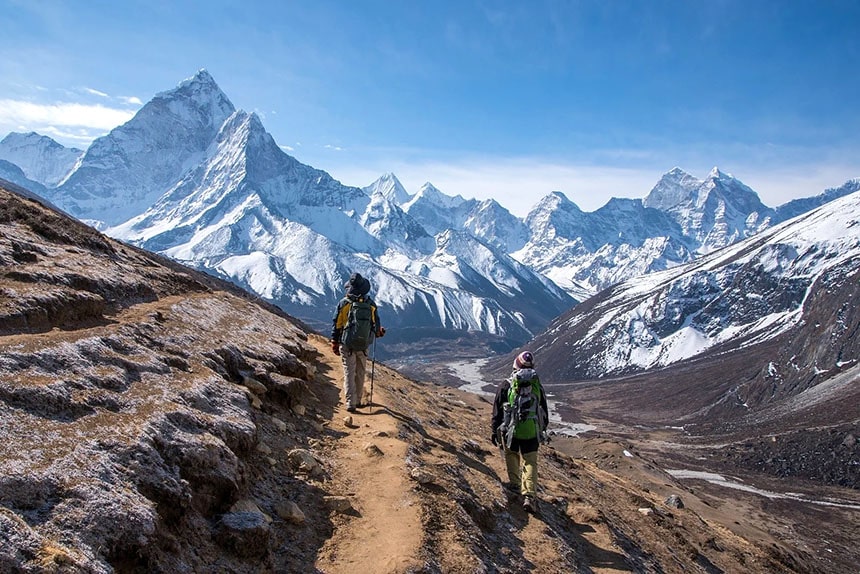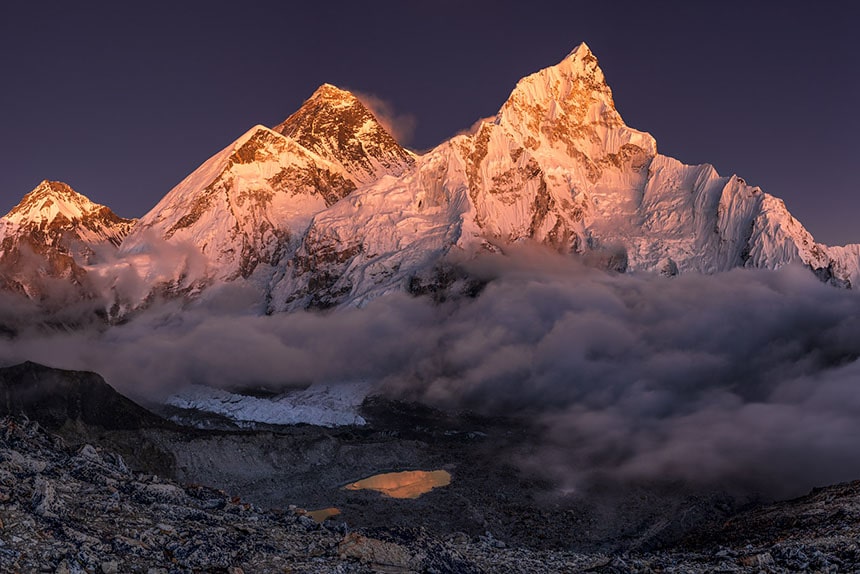Everest Base Camp trek
Trek duration: 12 days (short version)
Trek difficulty: Moderate
Max altitude: 5545m at Kala Patthar
Accommodation: Teahouses
Best time: March to May and October to December
The Everest Base Camp trek is one of the most iconic trekking routes in the Himalayas. Leading to the foot of the world’s highest mountain, this trek offers breathtaking views of snow-covered giants. Every step of the trail carries a sense of history, following in the footsteps of mountaineers who have aspired to reach the summit of Everest (8848m).
Unlike treks in Ladakh, which typically involve camping, the Everest region is lined with teahouses offering warm meals and simple rooms throughout the route. One of the most memorable moments of the trek is the climb to Kala Patthar (5545m), a rocky viewpoint that offers a stunning close-up of Everest and the surrounding peaks, especially beautiful at sunrise.
Although Everest is the star of the show, the route is dotted with panoramic ridges, glacial valleys, charming villages, and centuries-old monasteries. The trek is moderately challenging, suitable for fit hikers with good acclimatization. The short version of the Everest Base Camp trek takes 12 days, but it can take one or more extra days if you include a visit to Gokyo lakes or follow one of the alternative routes through the Three Passes. In terms of difficulty and duration, it is comparable to the Padum to Lamayuru trek in Zanskar.
Itinerary
Day 1: Lukla (2840m) - Phakding (2610m)
Time: 3-4 hrs
Distance: 8 km
The adventure begins with a dramatic flight from Kathmandu to Lukla airport, one of the highest airports in the world. After landing, the trek starts on a gentle note, descending through pine forests and crossing suspension bridges over the Dudh Koshi River. The trail leads to the small village of Phakding, where trekkers spend their first night in the Everest region.
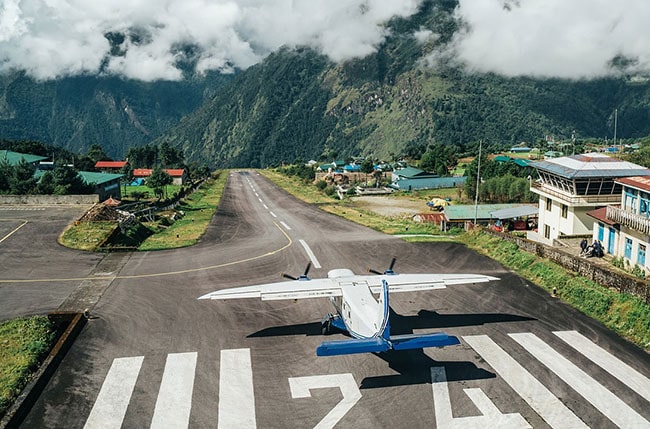
Day 2: Phakding (2610m) - Namche Bazaar (3440m)
Time: 5-6 hrs
Distance: 11 km
The trail continues along the river and enters Sagarmatha National Park. After several crossings of high suspension bridges and a steady ascent through conifer forests, trekkers reach Namche Bazaar. This bustling Sherpa town is the commercial hub of the Khumbu and offers bakeries, cafes, and impressive views of the surrounding peaks.
Day 3: Acclimatization day in Namche Bazaar
This is a rest day to help the body adapt to the altitude. Trekkers can take a short hike to a nearby viewpoint for panoramic views of Everest, Ama Dablam and Lhotse, or explore the surrounding Sherpa villages. In Khumjung, you can visit a small monastery that houses a supposed yeti scalp, a curious piece of local legend that adds a touch of mystery to the region. Staying active during the day supports the acclimatization process and prepares you for the higher elevations ahead.
Day 4: Namche Bazaar (3440m) - Tengboche (3860m)
Time: 5-6 hrs
Distance: 10 km
The trail ascends gradually, passing rhododendron forests and mani walls before descending to the Imja Khola. After a final climb, trekkers reach the hilltop monastery village of Tengboche, home to one of the most significant Buddhist monasteries in the region, with a backdrop of Ama Dablam and Everest.
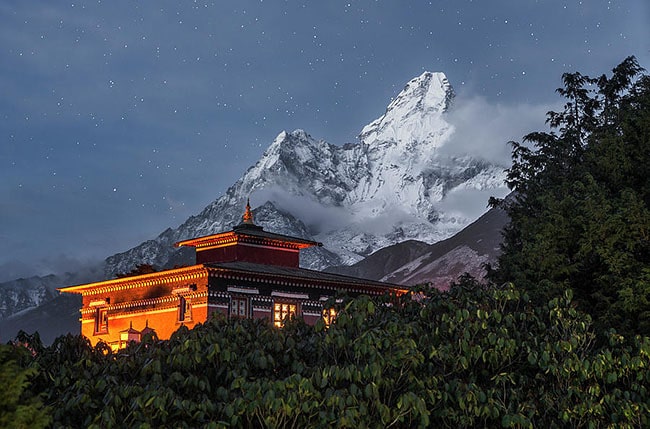
Day 5: Tengboche (3860m) - Dingboche (4410m)
Time: 5-6 hrs
Distance: 11 km
The path descends through forests and crosses a suspension bridge before climbing steadily past small villages and chortens. Dingboche, a picturesque village surrounded by stone walls and barley fields, offers sweeping views of the valley and surrounding peaks.
Day 6: Acclimatization day in Dingboche
A second rest day for altitude adjustment. Many trekkers hike up to Nagarjun Hill (5100m) for excellent views of Makalu, Lhotse, and Ama Dablam.
Day 7: Dingboche (4410m) - Lobuche (4910m)
Time: 4-5 hrs
Distance: 8 km
The landscape becomes more rugged as the trail follows the glacial moraine of the Khumbu Glacier. The route passes memorials dedicated to climbers and finally reaches Lobuche, a small settlement nestled below the towering Nuptse.
Day 8: Lobuche (4910m) - Gorak Shep (5164m) - Everest Base Camp (5364m) - Gorak Shep (5164m)
Time: 7-8 hrs
Distance: 13 km
This is the big day. After a morning trek to Gorak Shep, trekkers continue along the rocky glacial path to reach Everest Base Camp. While there are no views of Everest from the base camp itself, standing on the ice and rock where expeditions prepare for the summit is an unforgettable experience. The return to Gorak Shep completes a long and rewarding day.

Day 9: Gorak Shep (5164m) - Kala Patthar (5545m) - Pheriche (4240m)
Time: 7-8 hrs
Distance: 13 km
Before sunrise, an early climb leads to Kala Patthar, the highest point of the trek. This viewpoint offers amazing panoramas of Everest, Nuptse, and the Khumbu Glacier. After descending, the trail heads back to lower altitudes and the village of Pheriche.
Day 10: Pheriche (4240m) - Namche Bazaar (3440m)
Time: 6-7 hrs
Distance: 14 km
Retracing the path along the river and through alpine forests, trekkers return to Namche Bazaar for a well-earned rest.
Day 11: Namche Bazaar (3440m) - Lukla (2840m)
Time: 6-7 hrs
Distance: 19 km
The final day of walking follows the Dudh Koshi back to Lukla, where the trek ends.
Day 12: Flight from Lukla to Kathmandu
Weather permitting, the flight back to the capital provides one last glimpse of the Himalayas before the return to city life.
Major Highlights
| • | Reaching the legendary Everest Base Camp at 5364m |
| • | Sunrise views of Mount Everest from Kala Patthar (5545m) |
| • | Scenic flight in and out of Lukla |
| • | Sherpa culture and traditional Buddhist monasteries |
| • | Teahouse hospitality throughout the trek |
| • | Panoramic views of peaks like Lhotse, Nuptse, and Ama Dablam |
| • | Experiencing high-altitude trekking without technical climbing |
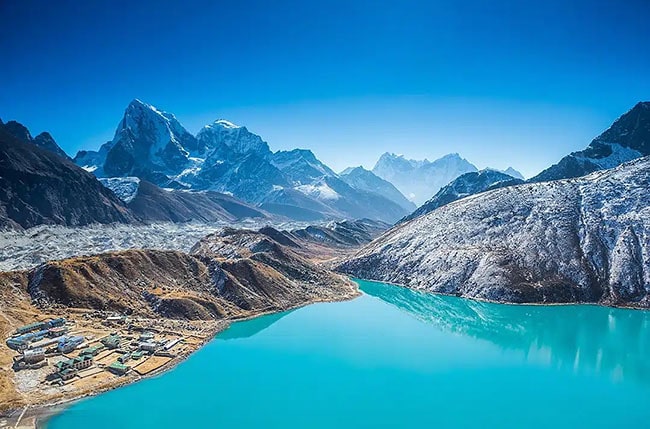
Alternative Routes
| • | Three Passes Trek: A challenging route that crosses Renjo La, Cho La, and Kongma La, offering remote trails and fewer crowds. |
| • | Gokyo Lakes Trek: A stunning detour to a chain of high-altitude turquoise lakes with a climb to Gokyo Ri for a breathtaking view of Everest. |
| • | Everest Base Camp via Jiri: An old-school approach to Everest, starting with a longer hike through lower mountain villages before reaching the main trail. |


 Hemis to Tso Moriri
Hemis to Tso Moriri
